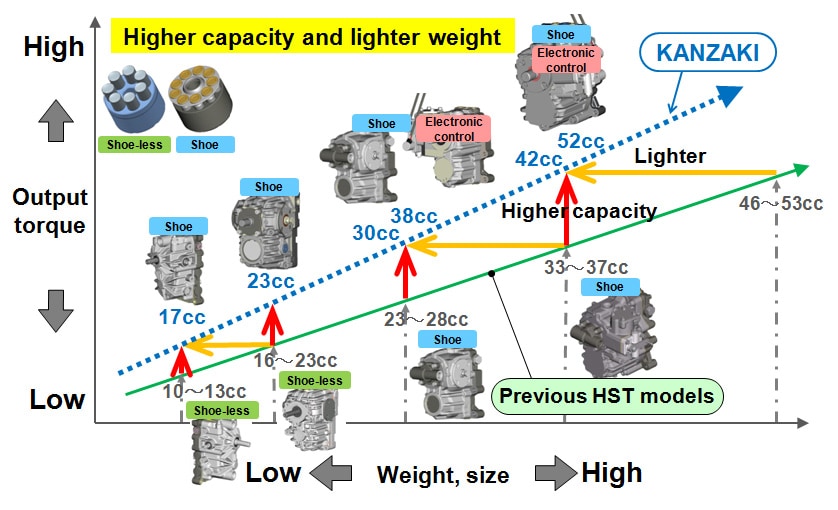Engineering & Development Dept.
KANZAKI KOKYUKOKI MFG.CO., LTD.
YANMAR Technical Review
Kanzaki Brand HSTs~High-Capacity HSTs~
Abstract
HSTs are installed on a wide variety of agricultural machinery used all over the world, including in US, European, and Asian markets.
This article describes the Kanzaki brand of HSTs.
1.Introduction
HST is an abbreviation for Hydro-Static Transmission. HSTs are closed-circuit power transmission mechanisms made up of a hydraulic axial piston pump and hydraulic axial piston motor. Neutral, forward, and reverse traveling can be selected by a single lever, with continuously variable gearing.
HSTs are installed on a wide variety of agricultural machinery (see Fig. 1) used all over the world, including in US, European, and Asian markets. This article describes the Kanzaki brand of HSTs.

2.Basic Features of HSTs
2.1.Basic Configuration
Fig. 2 shows the components of an HST. These are: [1] An input shaft that transmits power from the engine, [2] An output shaft that transmits power from the HST to the vehicle, [3] A control lever that controls vehicle speed and traveling direction (forward/reverse), [4] A center case that transmits hydraulic power, [5] An axial piston pump, [6] An axial piston motor, [7] A variable swash plate that changes pump discharge quantity, [8] A fixed swash plate in the motor assembly, [9] A charge relief valve that determines the pressure of the hydraulic fluid supplied to the HST main circuit, [10] A check valve for closing the main circuit, [11] A relief valve that limits pressure increases in the main circuit, [12] A charge pump that makes up for leaks in the pump and motor, and [13] A housing that holds these components and keeps them immersed in lubricant. Fig. 3 shows an example of an HST hydraulic circuit.


2.2.Principle of Operation
[1] The HST input shaft rotates by the engine power and the HST pump that is connected with input shaft converts the rotational energy into hydraulic energy (flow rate and pressure). [2] When the angle of the variable swash plate is changed, the hydraulic energy is transmitted to the HST motor. [3] The HST motor converts the hydraulic energy back to rotational energy that is in turn transmitted via the output shaft to a sub-shift or other gear transmission. [4] The angle of the variable swash plate can be changed arbitrarily to provide continuously variable gearing in either forward or reverse traveling (see Fig. 4).

3.HST Product Range of Kanzaki Kokyukoki Mfg. Co., Ltd.
Kanzaki currently supplies HSTs with capacities ranging from 13cm3/rev. to 52cm3/rev., extending from low-cost shoe-less-type HSTs for light duty applications to shoe-type HSTs for heavy duty applications. Moreover, the series of high-capacity shoe-type HSTs can support either servo or electronic control operation. Together, these HST variants make up a product range that can satisfy a diverse variety of customer requirements (see Table 1).
Table 1 HST Series from Kanzaki Kokyukoki Mfg. Co., Ltd.

4.Activities of Kanzaki Kokyukoki Mfg. Co., Ltd.
4.1.Developments from HSTs
In addition to individual HST units, Kanzaki Kokyukoki Mfg. Co., Ltd. also develops system products that are ideal for each different types of machinery, including Integrated Hydro-static Transaxle (IHTs) that combine an HST and gear drive train in the same housing, Fulltime Drive System (FDS) transmissions for Yanmar combine harvesters, which incorporate two HSTs, and Integrated Hydro-static Mechanical Transmission (I-HMTs) that utilize HST technology (see Fig. 5).

4.2.Increasing HST Capacity
Kanzaki Kokyukoki Mfg. Co., Ltd. has accomplished increasing the output and reducing the weight of its HSTs compared to previous models and those of competitors by providing higher capacity under the same size of HST, thereby significantly increasing output torque (see Fig. 6).
- 13cm3/rev. shoe-less ⇒ 17cm3/rev. shoe-type: 2.2 times
- 23cm3/rev. shoe-less ⇒ 23cm3/rev. shoe-type: 1.4 times
- 23cm3/rev. shoe-type ⇒ 38cm3/rev. shoe-type: 1.4 times
- 37cm3/rev. shoe-type ⇒ 52cm3/rev. shoe-type: 1.4 times
* Calculated from capacity and relief setting pressure (see Table 1).

5.Special Features of HSTs from Kanzaki Kokyukoki Mfg. Co., Ltd.
This section describes the special features of compact servo mechanisms from Kanzaki Kokyukoki Mfg. Co., Ltd. These servos are made up of: [1] A servo piston, [2] A servo spool, [3] A variable swash plate, and [4] A control lever unit. The size of the servo mechanism is accomplished to be compact by incorporating the servo spool inside the servo piston (see Fig. 7).
Furthermore, servos from Kanzaki Kokyukoki Mfg. Co., Ltd. can support electronic control by replacing the control lever from mechanical control specification assembly to electronic control specification assembly (see Fig. 8).


The principle of operation is as follows (see Fig. 9).
- (1)The control lever ([4]) is operated by external input.
- (2)The servo spool ([2]) connected with the control lever ([4]) moves causing hydraulic pressure to be applied to port A.
- (3)From port A, hydraulic pressure is applied to the end surface of the servo piston ([1]), causing it to move.
- (4)The movement of the servo piston ([1]) changes the angle of the variable swash plate ([3]) that is connected with servo piston.
- (5)The change in the angle of the variable swash plate ([3]) causes hydraulic fluid to flow from the HST pump to the HST motor.
- (6)When the servo piston ([1]) reaches the position of the servo spool ([2]), which is determined by the amount of the control lever ([4]) control input, it cuts off the hydraulic pressure, causing the variable swash plate ([3]) to remain in arbitrary position.

6.Conclusions
Kanzaki has enhanced its HSTs to work with machinery that is larger or has higher output by providing higher capacity under the same size of HST. In the future, Kanzaki will develop the HSTs further to provide more advanced functions and support for electronic control so that they can be used in other types of machinery and sold in new markets. In addition, utilizing the HST accumulated technologies and consideration of the value and challenges for customers, Kanzaki will also propose system products such as transmissions with excellent quality.
-IMPORTANT-
The original technical report is written in Japanese.
This document was translated by Research & Development Management Division.
Author
